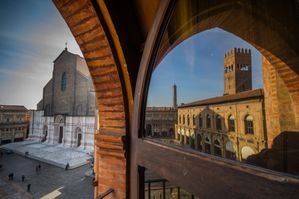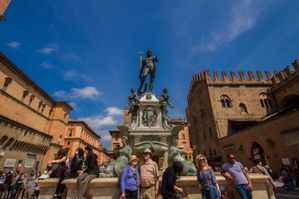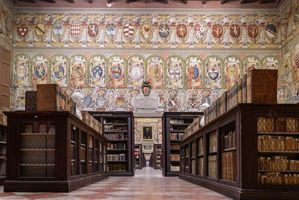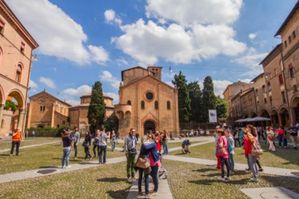THE QUADRILATERO
In this area, where the city's artisanal and mercantile tradition is still alive, you can taste typical products and sip wine in one of the numerous venues offering platters and other delicacies typical of the region. Nearby, you'll also find the famous Osteria del Sole, which since 1465 has been considered the symbol of the city's identity. Sitting at their wooden tables becomes an experience, convivially sharing a glass of wine, with food that everyone brings themselves.DA BERTINO
Since 1957, this tavern has been offering rustic dishes from the Bolognese tradition in a retro room lined with wood.
Over the years, it has become an institution of the city's typical cuisine, especially for its roast and boiled meat cart.OSTERIA BOTTEGA
Located in Via Santa Caterina, in the heart of the historic center, Osteria Bottega is famous for its traditional Bolognese cuisine with an innovative and creative touch.TRATTORIA DA ME
Founded in 1937, Trattoria Da Me offers creative variations of traditional dishes. Don't forget to try their famous Cotoletta.
Discover Bologna, Italy
Here are some top spots to explore to ensure you have an unforgettable experience in Bologna!
Traditional Cuisine
A "Home-Made" Experience
If you prefer a more intimate and less bustling atmosphere, you might consider booking a dinner with one of the Cesarine you can find in the city. They'll be ready to host you in their homes, where they can prepare a meal for their guests or offer the opportunity to participate in fresh pasta-making workshops. Here's the link to discover the project and the experiences they offer.
In this scenario, if you're keen on workshops, you might explore the chance to join a Cesarina in her home or participate in other city-based workshops where you can roll up your sleeves and get involved, like:
Don't forget to book these activities in advance!
Vegan Cuisine and Exotic Flavors in Bologna
VEGAN OPTIONS
Botanica Lab: A plant-based restaurant nestled in Bologna's historic center, known for its refined dishes.
FRAM Bistrot Bio Veg: A 100% organic bistro with a seasonal menu that changes daily.
UNO Caffè Olistico: A cozy spot offering activities and natural products to promote wellness for all.
ZEM Vegan Bistrot: Stop by for lunch or dinner and enjoy the finest locally sourced products.
ETHNIC RESTAURANTS
Sentaku Ramen: Dive into the world of Ramen and small appetizers in a cozy spot evoking Japanese tradition.
Taj Mahal Indian Halal Food Restaurant: Experience the flavors of India in the heart of Bologna.
Kabulàgna: A must-visit Afghan restaurant offering authentic cuisine.
Beirut Snack: Lebanese gastronomy with numerous vegetarian choices in a charming area of the city center.
Piazza Maggiore
The pulsating heart of the city, a result of centuries of transformations that have consistently defined its appearance and function. Piazza Maggiore hosts some of Bologna's most important buildings, including the Basilica of San Petronio, the Palazzo dei Notai, Palazzo d'Accursio - the seat of the Municipality housing the Municipal Art Collections, Palazzo del Podestà, Palazzo Re Enzo, and the more recent Palazzo dei Banchi.


Piazza del Nettuno
Born in the 16th century to highlight the statue of Neptune, from which it takes its name, the square was the result of expanding the existing space between Palazzo d'Accursio and Palazzo del Podestà by demolishing a block of buildings.
Within it, you'll find the statue of Neptune, crafted between 1563 and 1567 by the Flemish sculptor Jean de Boulogne, better known as Giambologna. On one side of the square is Sala Borsa, now the Civic Multimedia Library since 2001, and on the other side, next to Palazzo del Podestà, stands Palazzo Re Enzo.
Palazzo dell'Archiginnasio
Walking along Via dell'Archiginnasio, alongside the Basilica of San Petronio, you'll come across the Archaeological Civic Museum, renowned for its Egyptian collection, the third-largest in Italy, and Palazzo dell'Archiginnasio, one of Bologna's most significant buildings.
The latter was built by Cardinal Borromeo between 1562 and 1563, designed by the architect Antonio Morandi, and since 1838 has been home to the Municipal Library. Noteworthy is the Anatomical Theatre, constructed in carved wood by Antonio Levante in 1637 for anatomy lessons. Inside are the famous Flayed Figures by Ercole Lelli.


The Two Towers
The Asinelli Tower and the Garisenda Tower are the symbols of Bologna, rising in the heart of the city at the entrance of the ancient Via Emilia. Built during the Middle Ages for military purposes, they represented the social prestige of the families commissioning their construction.
The tallest, the Asinelli Tower, was built between 1109 and 1119 by the Asinelli family and passed to the Municipality in the following century. The Garisenda Tower, built during the same period, stands out for its lower height of only 47 meters. It is famous for its strong inclination, caused by ground and foundation subsidence, so much so that Dante included it in the XXXI Canto of the Inferno.
Piazza Santo Stefano
Piazza Santo Stefano is one of the most charming squares in Bologna, commonly considered a square, although it is actually a widening that opens from Via Santo Stefano leading to the homonymous complex, also known as the "Seven Churches".
Dominated by the Basilica of Santo Stefano, the square features Casa Berti and Palazzo Isolani on one side, and the sixteenth-century Palazzo Bolognini Amorini Salina on the other. Today, the square is often used to host cultural events, markets, and concerts.


Basilica of San Domenico
The Basilica of San Domenico is one of Bologna's most historically rich churches and was erected by the Dominican Friars as a place to preserve the remains of Saint Dominic, founder of the order, who arrived in Bologna around 1200. Inside are works of art by great artists such as Guercino, Filippino Lippi, and Ludovico Carracci.
In the Chapel of San Domenico stands the ark embellished with sculptures by Michelangelo, Nicola Pisano, Alfonso Lombardi, and Niccolò dell'Arca, also the author of the Lamentation over the Dead Christ preserved in the church of Santa Maria della Vita.
University Area
Bologna is home to the oldest university in the Western world, the Alma Mater Studiorum, whose foundation dates back to 1088. Via Zamboni, the quintessential university street, hosts various departments, the historic Teatro Comunale, and the renowned University Museums.
From Via Zamboni, heading towards Via Indipendenza, you can discover another Bologna - that of the underground waters re-emerging in the canal visible from the small window on Via Piella.

Museums, Foundations, and Art Galleries
The MAST Foundation
The MAST Foundation, established in Bologna in 2013, is an international institution that promotes the convergence of Technology, Art, and Innovation.
Its Gallery hosts two main components: the Innovation Gallery, which showcases industry and labor through interactive exhibitions and video art, and the Photo Gallery, dedicated to temporary exhibitions of industrial and labor photography. The Foundation also organizes cultural events such as talks, author meetings, and screenings.
Moreover, the MAST Foundation is renowned for its biennial showcase of industrial and labor photography called Foto/Industria, which extends beyond MAST and involves historical venues and public institutions in Bologna.
National Gallery of Bologna
The National Gallery of Bologna, located in the former Jesuit Novitiate of Sant'Ignazio dating back to the 1600s, is one of Italy's primary National Galleries. It was opened in 1885 and renovated in 1997.
Its collection includes works by great Italian masters of the Renaissance, Mannerism, and Baroque periods, including Raphael, Perugino, Tintoretto, Titian, the Carracci, Guercino, and Reni. In addition to the permanent exhibition, the gallery hosts temporary exhibitions and offers educational programs.
Opificio Golinelli
Opened in 2015, Opificio Golinelli is a multifunctional complex that integrates education, training, research, venture capital, dissemination, and promotion of sciences and arts by the Golinelli Foundation. It features laboratories, classrooms, offices, exhibition spaces, and an auditorium. Opposite Opificio, the Golinelli Arts and Sciences Center, established in 2017, fosters collaboration between art, science, and technology.
MAMbo - Bologna Museum of Modern Art
MAMbo, the Bologna Museum of Modern Art, opened its doors in 2007 within the former bread factory. It showcases Italian art from the post-war period to the present day, featuring a Permanent Collection and solo exhibitions of both Italian and international artists. Since 2012, it has temporarily housed the Morandi Museum.
A section dedicated to the International Performance Weeks of the 1970s and 1980s documents these significant artistic events. Marina Abramović and Ulay, among others, famously staged the performance Imponderabilia here in 1977, forcing visitors to squeeze between them to enter the museum.
The Morandi Museum boasts the world's largest public collection dedicated to Giorgio Morandi, comprising over 250 works that allow viewers to witness the artist's evolution.
The Communication Museum "Mille voci...mille suoni"
The Communication Museum is a museum that includes the Historical Museum of Radio, Gramophones, Cinema, and Mechanical Musical Instruments (1760-1960), recognized as a UNESCO Heritage Site. Through 800 objects, it tells the story from the origins to the present day of radio, phonography, mechanical musical machines, television, and Italian song.
Palazzo Pepoli - Museum of the History of Bologna
Palazzo Pepoli houses the Museum of the History of Bologna, offering a comprehensive overview of the city from its Etruscan era to the present day. The history is narrated through thematic exhibitions, emblematic figures, and anecdotes, using a combination of objects, images, and multimedia technologies.
Internationally renowned architect and designer Mario Bellini led the design and setup process, while architect Italo Lupi curated the graphic aspect, ensuring a high aesthetic standard. Additionally, since 2019, there has been a wing dedicated to Mortadella Bologna in collaboration with the Mortadella Bologna Consortium, further enriching the museum experience.
Palazzo Fava - Exhibition Palace
Palazzo Fava, a historic building in Bologna with medieval roots, reopened as the Exhibition Palace in 2011 after extensive restoration. The structure, with Renaissance influences, was purchased by the Fava family in 1546 and enriched by the Carracci with fresco cycles depicting the Stories of Jason and Medea. Today, it is a significant venue for exhibitions and cultural events, contributing to the cultural life of Bologna.
Palazzo Poggi Museum
In 1711, the Bolognese Senate acquired Palazzo Poggi, establishing the Institute of Sciences and Arts on the initiative of Luigi Ferdinando Marsili. This prestigious building, adorned with frescoes by renowned painters Pellegrino Tibaldi, Nicolò dell'Abate, and Prospero Fontana, now once again houses the rich collections of the rooms dedicated to geography and navigation, military architecture, physics, natural history, chemistry, human anatomy, and obstetrics, along with the sixteenth-century Aldrovandian museum, almost three centuries after its foundation.
International Museum and Library of Music
Opened in 2004 in Bologna's Palazzo Sanguinetti, this museum houses a valuable collection of printed music from the 16th to the 18th century, incunabula, manuscripts, opera librettos, and autographs. The museum also offers a reconstruction of the workshop of luthier Otello Bignami, an events hall, multimedia stations, educational workshops, space for temporary exhibitions, and a bookshop.
Via del Pratello
Via del Pratello is one of the few remaining examples of the original appearance of Bologna's historic center.
Pratello is a vibrant and dynamic neighborhood, particularly lively during the weekends, when it fills with life and energy thanks to the presence of the local community and young people.
It stretches for 600 meters, from Piazza San Francesco, home to the wonderful Basilica of the same name, to Piazza San Rocco. It hosts bars, restaurants, pubs, breweries, as well as artisan workshops, herbal shops, cultural clubs, and venues for theater and cinema companies.
Via Mascarella
Just steps away from the university area, Via Mascarella has earned the nickname "Jazz Street" over the years, thanks to the presence of excellent venues that combine good food with great music.
Here you'll find Cantina Bentivoglio, a jazz icon, known for its extensive wine list featuring over four hundred labels and its rooms with exposed bricks and vaulted ceilings, adorned with historic posters. Or Mustache, the most bohemian spot on Via Mascarella, where you might stumble upon a DJ set during aperitivo hours, or Modo Info Shop, an independent bookstore that hosts events like book presentations and theatrical readings. The bookstore also has a bar where musical groups often perform.
Mercato delle Erbe
The Mercato delle Erbe in Bologna is a lively food market in the heart of the city, renowned for its authentic Emilian cuisine. In addition to selling fresh products, it hosts a variety of gastronomic establishments offering traditional Bolognese dishes.
At night, the market transforms into a bustling meeting point, with bars, cafes, and restaurants offering atmosphere and culinary delights until late. It's the perfect place to immerse yourself in Bologna's nightlife, enjoying local specialties and soaking in the lively atmosphere of the city. Don't miss the Bar Senza Nome, a small venue run by deaf individuals who have made inclusion their greatest innovation.
University District
Home to most of the departments of the University of Bologna, the Municipal Theater, and the National Gallery, the University District is centered around Via Zamboni and Piazza Verdi.
It's an area in constant flux, as transient as it is familiar, in its cyclical nature and unresolved conflicts, elements that have become part of its identity.
Between Piazza Aldrovandi, Via Petroni, Piazza Verdi, Via delle Belle Arti, or Via Irnerio, you can immerse yourself in the city's most "riotous" nightlife.
Discover WMF – We Make Future 2025!
From June 4th to 6th, 2025, Bologna will host the largest trade fair on Artificial Intelligence, Technology, and Digital Innovation. Three days with over 100 events and a unique format combining Exhibition Area, Training, B2B Meetings, Networking, Culture, Concerts, Shows, and Entertainment within the spaces of BolognaFiere.
Discover the first 42 training stages out of more than 90 and the first confirmed speakers at WMF25 – get your Ticket now!
Discover how to get to our BolognaFiere location and easily explore Bologna.
Plus, if you haven't already, we recommend booking your hotel stay to make the most of your time in the city.

Venice
About 150 km away, reachable by train in approximately 1 hour and 30 minutes, awaits the magical city of canals. With its romantic gondolas, St. Mark's Square, and picturesque bridges, Venice offers a unique and unforgettable experience.

Florence
Around 100 km from Bologna, reachable by train in just over an hour, you'll find the cradle of the Renaissance. Florence is famous for its museums, such as the Uffizi Gallery, the Duomo with its magnificent dome, and the historic Ponte Vecchio.

Rome
The capital of Italy, situated about 300 km from Bologna, is reachable by train in about 2 hours. Rome is an open-air museum, featuring the Colosseum, the Vatican, and the Trevi Fountain among its many must-see attractions.






